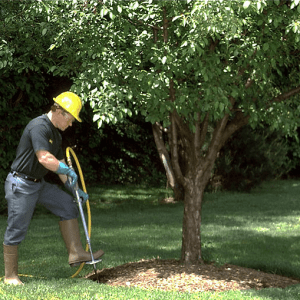Fertilizing Trees and Shrubs
Trees and shrubs growing in their natural habitats rarely display symptoms of nutrient deficiency. This is due not only to the natural recycling of nutrients that occurs in nature, but also to the fact that plants in the wild will grow only where they are best adapted or have a competitive advantage.
Urban landscape trees often grow in soils that do not contain sufficient available nutrients for growth and development. Fertilizing a tree can increase growth, reduce susceptibility to certain diseases and pests and can even help reverse declining health.
 The correct amount of fertilizer can promote healthy flower production and foliage growth while an excessive fertilizer application can decrease plant health and can lead to decline and death. Over application or incorrect application of fertilizer can contribute to polluting our rivers, streams, lakes, and estuaries. Excess fertilizer can increase the likelihood of some plant diseases.
The correct amount of fertilizer can promote healthy flower production and foliage growth while an excessive fertilizer application can decrease plant health and can lead to decline and death. Over application or incorrect application of fertilizer can contribute to polluting our rivers, streams, lakes, and estuaries. Excess fertilizer can increase the likelihood of some plant diseases.
Fertilizing plants that have already outgrown their allotted space can only lead to more pruning. A moderate rate of growth and good, green color is desired for most woody plants. Excessive vigor, which is evident by lush, green leaves and long shoot growth is often undesirable.
Such plants are more susceptible to injury by cold in winter, are more likely to be broken during wind and ice storms, and usually will require more pruning than plants making moderate growth.
Reasons to fertilize may include some of the following symptoms:
- light green or yellow leaves
- leaves with dead spots
- leaves smaller than normal
- fewer leaves and/or flowers than normal
- short, annual twig growth
- dying back of branches at the tips
- wilting of foliage





